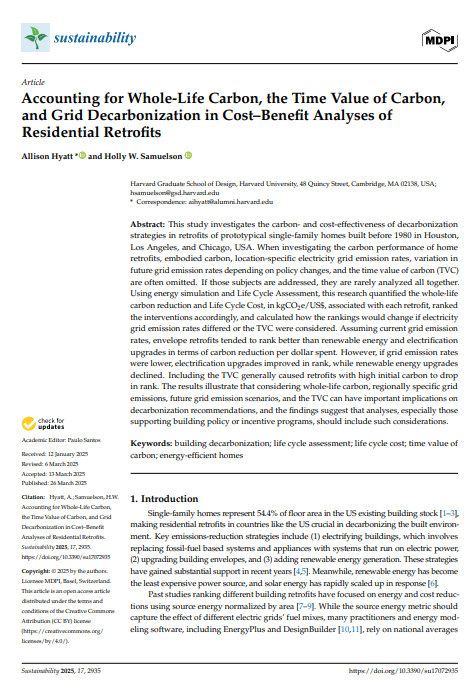Accounting for Whole-Life Carbon, the Time Value of Carbon, and Grid Decarbonization in Cost–Benefit Analyses of Residential Retrofits
This study investigates the carbon- and cost-effectiveness of decarbonization strategies in retrofits of prototypical single-family homes built before 1980 in Houston, Los Angeles, and Chicago, USA. When investigating the carbon performance of home retrofits, embodied carbon, location-specific electricity grid emission rates, variation in future grid emission rates depending on policy changes, and the time value of carbon (TVC) are often omitted. If those subjects are addressed, they are rarely analyzed all together. Using energy simulation and Life Cycle Assessment, this research quantified the whole-life carbon reduction and Life Cycle Cost, in kgCO2e/US$, associated with each retrofit, ranked the interventions accordingly, and calculated how the rankings would change if electricity grid emission rates differed or the TVC were considered. Assuming current grid emission rates, envelope retrofits tended to rank better than renewable energy and electrification upgrades in terms of carbon reduction per dollar spent. However, if grid emission rates were lower, electrification upgrades improved in rank, while renewable energy upgrades declined. Including the TVC generally caused retrofits with high initial carbon to drop in rank. The results illustrate that considering whole-life carbon, regionally specific grid emissions, future grid emission scenarios, and the TVC can have important implications on decarbonization recommendations, and the findings suggest that analyses, especially those supporting building policy or incentive programs, should include such considerations.
This work received funding from the Harvard Joint Center for Housing Studies, the Harvard Graduate School of Design, and RDH Building Science.

